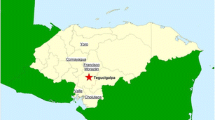Abstract
The retrospective study (2002–2007) for human leptospirosis in Vojvodina was undertaken in order to describe the distribution of the disease in relation with some environmental factors. Regarding the presented results, the major detected number of leptospirosis cases concurs with stagnant waters, wetlands, fish pond areas and protected regions, which comprised the basis for map** of the region in three risk zones: very high risk (incidence rate higher than 5.0), high risk (2.5–5.0) and medium risk of leptospirosis infection (1.0–2.5). During the investigated period, 97 cases were registered with an average of 13.85 cases per year: 2002, 32 cases; 2003, 7; 2004, 22; 2005, 16; 2006, 4 and 2007, 16. Out of these 97 cases only 5 were women. Serovars from 11 presumptive serogroups caused infection, with a predominance of Icterohaemorrhagiae and Bratislava, accounting for 72.72% of cases together. Icterohaemorrhagiae was the commonest infecting serogroup mostly connected with fish ponds. Case fatality ratio was 9.4%.
Similar content being viewed by others
References
Vieira M L, Gama-Simoes M J, Collares-Pereira M. Human leptospirosis in Portugal: a retrospective study of eighteen years. Internat J Infect Dis, 2005, 10: 378–386 10.1016/j.ijid.2005.07.006
Jansen A, Schöneberg I, Frank C, et al. Leptospirosis in Germany, 1962–2003. Emerg Infect Dis, 2005, 11: 1048–1054 16022779
Ko A I, Reis M G, Dourado C M R, et al. Urban epidemic of severe leptospirosis in Brazil. Lancet, 1999, 354: 820–825 1:STN:280:DyaK1MvhtlOgtg%3D%3D, 10485724
WHO. Leptospirosis worldwide. Weekly Epidemiological Record, 1999, 74: 237–244
Plank R, Dean D. Overview of the epidemiology, microbiology, and pathogenesis of Leptospira spp. in humans. Microbes Infection, 2000, 2: 1265–1276 10.1016/S1286-4579(00)01280-6, 1:CAS:528:DC%2BD3cXntlSgtb8%3D
Levett P N. Leptospirosis. Clin Microbiol Rev, 2001, 14: 296–326 10.1128/CMR.14.2.296-326.2001, 1:CAS:528:DC%2BD3MXjtlKhtrY%3D, 11292640
Meites E, Jay M T, Deresinski S, et al. Reemerging Leptospirosis, California. Emerg Infect Dis, 2004, 10: 406–412 15109405
Yanagihara Y, Villanueva S Y A M, Yoshida S, et al. Current status of leptospirosi in Japan and Philippines. Comparative Immunology. Microbio Infect Dis, 2007, 30: 399–413 10.1016/j.cimid.2007.05.003
Vijayachari P, Sugunan A P, Sharma S, et al. Leptospirosis in the Andaman Islands, India. Trans R Soc Trop Med Hyg, 2008, 102: 117–122 10.1016/j.trstmh.2007.08.012, 1:STN:280:DC%2BD1c%2Fis1SntQ%3D%3D, 17991499
Čanak G, Vukobratov Z, Đorđević M, et al. Leptospirosis in the clinic for infectious disease in Novi Sad in the period 1984–1993. Medicinki pregled, 1995, 73: 323–326
Svirčev Z, Krstić S, Simeunović J, et al. Comparative analysis of water quality methods for the monitoring of eutrophication regarding implementation of WFD in Serbia. Geog Pannon, 2006, 10: 33–43
Simeunović J, Svirčev Z, Krstić S, et al. Occurance of cyanobacterial blooms in Vojvodina water ecosystems. Geog Pannon, 2008, 9: 13–19
Svirčev Z, Simeunović J, Subakov-Simić G, et al. Freshwater cyanobacterial blooms and cyanotoxin production in Serbia in the past 25 years. Geog Pannon, 2008, 11: 32–38
Republic Hydrometeorological Department. Water quality yearbooks. Republic Hydrometeorological Department, 2002–2008, Belgrade
Krstić S, Svirčev Z, Levkov Z, et al. Selecting appropriate bioindicator regarding the WFD guidelines for freshwaters — a Macedonian experience. Inter J on Algae, 2007, 9: 41–63 10.1615/InterJAlgae.v9.i1.30
Matavulj M. The non-specific phospho-monoester-hydrolases of microorganisms and their significance in phosphorus cycle in aquatic environments (dissertation). Zagreb: University of Zagreb, 1986.
The American Public Health Association. Standard methods for the examination of water and wastewater, 21st edition. Washington: American Public Health Association Publications, 2005.
Republic Statistical Office. Results of census in 2002. Republic Statistical Office. Belgrade, 2003.
Baranton G, Postic D. Trends in leptospirosis epidemiology in France. Sixty-six years of passive serological surveillance from 1920 to 2003. Inter J of Infect Dis, 2006, 10: 162–170 10.1016/j.ijid.2005.02.010
Jansen A, Luge E, Guerra B, et al. Leptospirosis in Urban Wild Boars, Berlin, Germany. Emerg Infect Dis, 2007, 13: 739–742 17553254
World Health Organization. Human leptospirosis: guidance for diagnosis, surveillance and control. Malta: World Health Organization, International Leptospirosis World Health Organization, 2003.
Robertson M H, Clarke I R, Coghlan J D, et al. Leptospirosis in trout farmers. Lancet, 1981, 318: 626–627 10.1016/S0140-6736(81)92757-4
Gill N, Waitkins S A, Calder I M. Further update on leptospirosis: Continuing risk in fish farmers. British Med J, 1985, 290: 1988 10.1136/bmj.290.6486.1988, 1:STN:280:DyaL2M3islarug%3D%3D
Davidson L S P, Smith J. Weil’s disease in the north-east of Scotland. British Med J, 1939, 754–757
Waitkins S A. An update on leptospirosis. Commun Dis Rep, 1984, 44: 3–4
Kondratenko V F, Bunin I K, Rodionova N S, et al. A natural focus of icterohemorrhagic leptospirosis in the floodplain of the lower Don and means for its eradication. Microb Epidem Immunobiol, 1988, 5: 38–41
Staneck J L, Henneberry R C, Cox C D. Growth requirements of pathogenic Leptospira. Infection and Immunity, 1973, 7: 886–897 1:CAS:528:DyaE3sXktl2qsbY%3D, 4716547
Shenberg E. Growth of pathogenic Leptospira in chemically defined media. J Bacter, 1967, 93: 1598–1606 1:CAS:528:DyaF2sXhtFeisbo%3D
Vine M F, Degnan D, Hanchette C. Geographic information systems: Their use in environmental epidemiologic research. Environ Health Perspect, 1997, 105: 598–605 10.2307/3433605, 1:STN:280:DyaK2svjsVKjug%3D%3D, 9288494
Diez-Roux A V. Bringing context back into epidemiology: Variables and multilevel analysis. American J Pub Health, 1998, 88: 216–222 10.2105/AJPH.88.2.216, 1:STN:280:DyaK1c7ltFOisg%3D%3D
Barcellos C, Sabroza P C. The place behind the case: leptospirosis risks and associated environmental conditions in a flood-related outbreak in Rio de Janeiro. Cad Saúde Pública, 2001, 17(Supl.): 59–67 11426266
Author information
Authors and Affiliations
Corresponding author
Additional information
Surpported by the funding of the European Agency for Reconstruction Through the Ministry of International Economic Relations within the Neighboring Program Hungary-Serbia (Grant No. 04SER02/01/009) and Ministry of Science and Environmental Protection of the Republic of Serbia (Grant No. 146021B)
Rights and permissions
About this article
Cite this article
Svirčev, Z., Marković, S.B., Vukadinov, J. et al. Leptospirosis distribution related to freshwater habitats in the Vojvodina region (Republic of Serbia). SCI CHINA SER C 52, 965–971 (2009). https://doi.org/10.1007/s11427-009-0124-2
Received:
Accepted:
Published:
Issue Date:
DOI: https://doi.org/10.1007/s11427-009-0124-2




